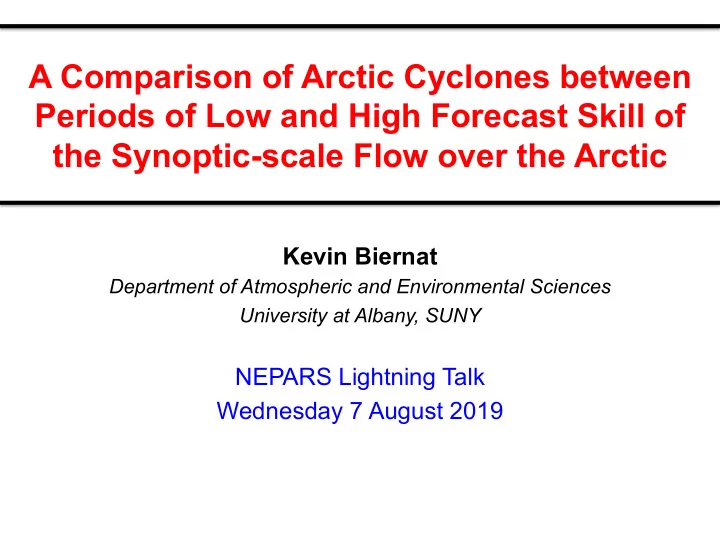

A Comparison of Arctic Cyclones between Periods of Low and High Forecast Skill of the Synoptic-scale Flow over the Arctic Kevin Biernat Department of Atmospheric and Environmental Sciences University at Albany, SUNY NEPARS Lightning Talk Wednesday 7 August 2019
Arctic cyclones (ACs) are synoptic-scale cyclones that may originate within the Arctic or move into the Arctic from lower latitudes (e.g., Crawford and Serreze 2016) Example: The Great Arctic Cyclone of August 2012 (AC12) 0000 UTC 6 Aug 2012 300-hPa wind speed (m s − 1 , shaded); 1000–500-hPa thickness (dam, blue/red); SLP (hPa, black); PW (mm, shaded) Data source: ERA5 L1 AC12 (m s − 1 ) (mm) 30 40 50 60 70 80 90 100 25 30 35 40 45 50 55
Methodology • Created a 2007–2017 climatology of ACs • Determined low and high forecast skill periods over the Arctic using GEFS reforecast dataset v2 and ECMWF Ensemble Prediction System • Compared characteristics of Arctic cyclones and synoptic-scale flow patterns associated with Arctic cyclones between low and high forecast skill periods
AC Track Frequency Low skill (N = 401) High skill (N = 345) 0.005 0.02 0.04 0.06 0.08 0.01 0.03 0.05 0.1 0.12 0.14 0.16 0.18 0.2 Total number of ACs within 500 km of a grid point, divided by number of days in period (number of ACs day − 1 )
AC Track Frequency Differences Low skill minus high skill 0 -0.08 -0.06 -0.05 -0.04 -0.03 -0.02 -0.01 -0.005 0.005 0.01 0.02 0.03 0.04 0.05 0.06 0.08 Difference in AC track density (number of ACs day − 1 )
Flow Amplitude Arctic flow amplitude metric 1.1 Anomalously amplified flow 1.0 0.9 0.8 deamplified flow Anomalously 0.7 0.6 0.5 -120 -96 -72 -48 -24 0 Hours relative to 0000 UTC of low and high skill days 1979–2017 climo mean statistically significant statistically significant shading: difference between low-skill mean difference between low interquartile low/high skill mean and high skill means range high-skill mean and climo mean
Recommend
More recommend